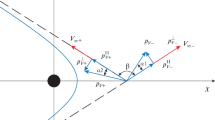Abstract
In this paper, the method of changing the trajectories of hazardous asteroids with orbits known for some years to be on a possible collision course with the Earth is considered. The method relies on the use of small asteroids (asteroid-projectiles) directed at hazardous celestial bodies by giving the projectile a sufficiently small velocity impulse ensuring the Earth gravity assist. As a result, the asteroid-projectile vector can be controllably changed over a wide range. Apophis is considered as an example of the target asteroid. The technical feasibility of this method is discussed. It is noted that despite the potential use of this elegant method, its practical implementation requires further research and development.
Similar content being viewed by others
References
Brophy, J., Culick, F., Dimotakis, P., and Friedman, L., A safe stepping stone into the solar system, Proc. 63rd Int. Astron. Congr. Naples, Oct. 2012.
Eismont, N., Boyarsky, M., Ledkov, A., et al., Using small asteroids to deflect larger dangerous asteroids, Proc. 23rd Int. Symp. on Space Flight Dynamics, Pasadena, 2012. https://issfd.jpl.nasa.gov/home/assets/papers/ISSFD23-IMD2-1.pdf
Gooding, R.H., A procedure for solution of Lambert’s orbital boundary-value problem, Celest. Mech. Dyn. Astron., 1990, vol. 48, no. 2, pp. 145–165.
JPL Small-Body Browser: 99942 Apophis (2004 MN4). http:/ssd.jpl.nasa.gov/sbdb.cgi?sstr=99942
Lancaster, E.R. and Blanchard, R.C., A unified form of Lambert’s theorem, NASA Tech. Note no. TN D-5363, 1969.
Medvedev, Yu.D., Sveshnikov, M.L., Timoshkova, E.I., et al., Asteroidno-kometnaya opasnost’ (Asteroid-Cometary Danger), St. Petersburg: Inst. Teoret. Astron. RAS, Mezhdunar. Inst. Probl. Asteroid. Opasn., 1996.
Mikisha, A.M., Smirnov, M.A., and Smirnov, S.A., The way to bring asteroid into near-Earth space, in Okolozemnaya astronomiya (kosmicheskii musor) (Near-Earth Astronomy (Space Debris)), Moscow: Kosmosinform, 1993, pp. 264–277.
Nazirov, R.R. and Eismont, N.A., Gravitational maneuvers as a way to turn small asteroids to the meeting trajectory with dangerous near-Earth objects, Kosm. Issl., 2010, vol. 48, no. 5, pp. 491–496.
Shustov, B.M., On coordinated approach to the problem on asteroid-cometary danger, Kosm. Issl., 2010, vol. 48, no. 5, pp. 388–401.
Spacecraft Attitude Determination and Control, Wertz, J.R., Ed., Reidel Publ., 1985.
Author information
Authors and Affiliations
Additional information
Original Russian Text © N.A. Eismont, M.N. Boyarskii, A.A. Ledkov, R.R. Nazirov, D.W. Dunham, B.M. Shustov, 2013, published in Astronomicheskii Vestnik, 2013, Vol. 47, No. 4, pp. 352–360.
Rights and permissions
About this article
Cite this article
Eismont, N.A., Boyarskii, M.N., Ledkov, A.A. et al. On the possibility of the guidance of small asteroids to dangerous celestial bodies using the gravity-assist maneuver. Sol Syst Res 47, 325–333 (2013). https://doi.org/10.1134/S0038094613040102
Received:
Published:
Issue Date:
DOI: https://doi.org/10.1134/S0038094613040102



